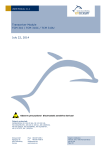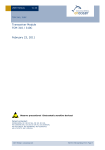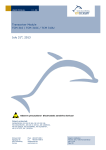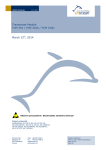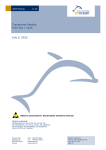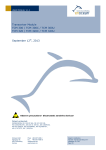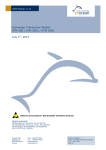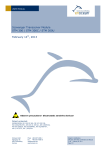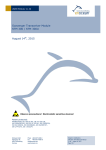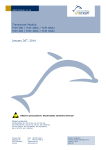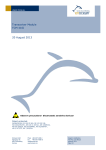Download EnOcean TCM 310C User manual
Transcript
USER MANUAL V1.3 Transceiver Module TCM 310 / TCM 310C / TCM 310U Nov 20, 2014 Observe precautions! Electrostatic sensitive devices! Patent protected: WO98/36395, DE 100 25 561, DE 101 50 128, WO 2004/051591, DE 103 01 678 A1, DE 10309334, WO 04/109236, WO 05/096482, WO 02/095707, US 6,747,573, US 7,019,241 EnOcean GmbH Kolpingring 18a 82041 Oberhaching Germany Phone +49.89.67 34 689-0 Fax +49.89.67 34 689-50 [email protected] www.enocean.com Subject to modifications TCM 310 / 310C / TCM 310U User Manual November 20, 2014 Page 1/29 USER MANUAL V1.3 TCM 310 / TCM 310C / TCM 310U REVISION HISTORY The following major modifications and improvements have been made to the first version of this document: No 1.00 1.01 1.02 1.03 1.04 1.05 1.06 1.07 1.08 1.1 1.15 1.2 1.3 Major Changes Initial version Modification for Step Code DB; increased number of filters and Smart Ack mailboxes Supply voltage range extended Start-up time and current consumption in deep sleep mode added in 2.2; improved layout recommendations in 3.5 Antenna recommendations removed and referred to application note AN102 and AN105; Maximum Rating for IOVDD modified (IOVDD may now exceed VDD); Additional information in 3.6; Chapter “Related Documents” added; pin numbers added in 3.2; update of FCC grant in 5.2; parameters for antenna requirements relaxed in 4.2.1.; Error in table in 3.2 corrected (pin 17 and 18 need to be connected to GND as shown in figure above) Supply voltage range extended; start-up time from sleep added TCM 310U added Mitsubishi Materials Chip Antenna added to limited modular approval Updated power supply filter recommendation Added Start-up Time Parameter, Changed Vmin Duty cycle lock added in 3.6 and 5.1, and selective repeating added in 3.7 Modified pin description in 3.2. Added 3.10 Published by EnOcean GmbH, Kolpingring 18a, 82041 Oberhaching, Germany www.enocean.com, [email protected], phone +49 (89) 6734 6890 © EnOcean GmbH All Rights Reserved Important! This information describes the type of component and shall not be considered as assured characteristics. No responsibility is assumed for possible omissions or inaccuracies. Circuitry and specifications are subject to change without notice. For the latest product specifications, refer to the EnOcean website: http://www.enocean.com. As far as patents or other rights of third parties are concerned, liability is only assumed for modules, not for the described applications, processes and circuits. EnOcean does not assume responsibility for use of modules described and limits its liability to the replacement of modules determined to be defective due to workmanship. Devices or systems containing RF components must meet the essential requirements of the local legal authorities. The modules must not be used in any relation with equipment that supports, directly or indirectly, human health or life or with applications that can result in danger for people, animals or real value. Components of the modules are considered and should be disposed of as hazardous waste. Local government regulations are to be observed. Packing: Please use the recycling operators known to you. © 2014 EnOcean | www.enocean.com TCM 310 / TCM 310C / TCM 310U User Manual | v1.3 | November 2014| Page 2/29 USER MANUAL V1.3 TCM 310 / TCM 310C / TCM 310U TABLE OF CONTENT 1 2 MODULE VARIANTS AND RELATED DOCUMENTS ............................................... 4 GENERAL DESCRIPTION ................................................................................. 4 Basic functionality ......................................................................................... 4 Technical data............................................................................................... 5 Physical dimensions ....................................................................................... 6 Environmental conditions ............................................................................... 6 Ordering information...................................................................................... 6 FUNCTIONAL DESCRIPTION ............................................................................ 7 3.1 Pin out ......................................................................................................... 7 3.2 Pin description and operational characteristics................................................... 7 3.2.1 GPIO supply voltage - IOVDD...................................................................... 8 3.3 Absolute maximum ratings (non operating) ...................................................... 8 3.4 Maximum ratings (operating) .......................................................................... 8 3.5 System environment ...................................................................................... 9 3.6 Serial Interface ............................................................................................. 9 3.7 Built-in Repeater ......................................................................................... 10 3.8 Smart Acknowledge ..................................................................................... 12 3.9 Remote Management ................................................................................... 12 3.10 Suggested reset circuitry ......................................................................... 12 2.1 2.2 2.3 2.4 2.5 3 4 APPLICATIONS INFORMATION....................................................................... 13 4.1 Transmission range ..................................................................................... 13 4.2 Antenna options .......................................................................................... 14 4.2.1 Overview ................................................................................................ 14 4.2.2 Whip antenna ......................................................................................... 14 4.2.3 Helical antenna ....................................................................................... 15 4.2.4 Chip antenna (supplier: Mitsubishi Material, Type AM11DG-ST01) ................. 16 4.3 Recommendations for laying a whip antenna .................................................. 17 4.4 Power supply requirements ........................................................................... 18 4.5 Layout recommendations ............................................................................. 18 4.5.1 Recommended foot pattern....................................................................... 19 4.6 Soldering information................................................................................... 22 4.7 Tape & Reel specification .............................................................................. 23 5 5.1 5.2 5.3 5.4 5.5 AGENCY CERTIFICATIONS ............................................................................ 24 CE approval ................................................................................................ 24 FCC (United States) Certification ................................................................... 25 FCC Regulatory Statements ......................................................................... 27 IC (Industry Canada) Certification ................................................................. 28 Industry Canada Regulatory Statements ........................................................ 29 © 2014 EnOcean | www.enocean.com TCM 310 / TCM 310C / TCM 310U User Manual | v1.3 | November 2014| Page 3/29 USER MANUAL V1.3 TCM 310 / TCM 310C / TCM 310U 1 MODULE VARIANTS AND RELATED DOCUMENTS This document describes operation of TCM 310 modules available in variations for following frequencies: TCM 310 : TCM 310C: TCM 310U: 868.300 MHz 315.000 MHz 902.875 MHz In side this manual the following terms TCM 310x can be used interchangeably for any of the above frequency. This document describes operation of TCM 310x modules with their built-in firmware. In addition we recommend following our application notes, in particular AN101: Power Supply Layout – Layout considerations for Line-Power AN102: Antenna Basics – Basic Antenna Design Considerations for EnOcean based Products AN105: 315 MHZ Internal Antenna Design – Considerations for EnOcean based Products The specification of the serial protocol ESP3 can be found here: http://www.enocean.com/en/enocean_modules/tcm-310/ 2 2.1 GENERAL DESCRIPTION Basic functionality TCM 310x is a SMD mountable radio transmitter module enabling the realization of gateways for EnOcean 868 MHz, 315 MHz and 902 MHz radio systems. It provides a bi-directional radio interface and a bidirectional serial interface. Radio messages are sent transparently through the serial interface in both directions from and to an externally connected host processor or host PC. In addition control commands can be sent from the host, e.g. to configure the repeater functionality or to manage Smart Ack functions. TCM 310x can act as postmaster for up to 20 bi-directional sensors using Smart Ack technology. Features Smart Ack controller functionality Transparent radio channel Programmable repeater functionality (1 / 2 Level) ESP3 support (EnOcean Serial Protocol V3) Not API programmable! © 2014 EnOcean | www.enocean.com TCM 310 / TCM 310C / TCM 310U User Manual | v1.3 | November 2014| Page 4/29 USER MANUAL V1.3 TCM 310 / TCM 310C / TCM 310U 2.2 Technical data Antenna Frequency Radio Standard Data rate/Modulation type Receiver Sensitivity (at 25 °C) Conducted Output Power Power Supply Start-up Time Serial Interface Current Consumption Dimensions of PCB Operating temperature Radio Regulations 1) According to ISO/IEC 14543-3-10 © 2014 EnOcean | www.enocean.com TCM 310 : external whip or 50 Ω antenna mountable TCM 310C: external whip TCM 310U: external whip or Helical antenna TCM 310 : 868.300 MHz (ASK)1) TCM 310C: 315.000 MHz (ASK)1) TCM 310U: 902.875 MHz (FSK) Enocean 868 MHz/315 MHz: ISO/IEC 14543-3-10 125 kbps typ. –96 dBm (868.300 MHz) 2) typ. -98 dBm (315.000 MHz) 2) typ. -98 dBm (902.875 MHz) 2) typ. 3 dBm @ 315 and 868 MHz / 1 dBm @ 902.875 MHz 2.6V … 3.5 V <500ms UART Receive mode: 33 mA Transmit mode: 24 mA 22x19x3 mm 0 to +65 °C R&TTE EN 300 220 (TCM 310) v.2.4.1 FCC CFR-47 Part 15 (TCM 310C / TCM 310U) 2) @ 0.1% telegram error rate based on transmitted sub-telegrams TCM 310 / TCM 310C / TCM 310U User Manual | v1.3 | November 2014| Page 5/29 USER MANUAL V1.3 TCM 310 / TCM 310C / TCM 310U 2.3 Physical dimensions Unless otherwise specified dimensions are in mm. Tolerances: PCB outline dimensions 0.2 mm All other tolerances 0.1 mm TCM 310 (pads on bottom side of PCB!) PCB Dimension 22 x 19 x 3.1 mm Weight 2.4 1.9 g Environmental conditions Operating temperature -0 °C … +65 °C Storage temperature -40 °C … +85 °C Storage temperature in tape & reel package -20 °C … +50 °C Humidity 2.5 0% … 93% r.H., non-condensing Ordering information Type TCM 310 TCM 310C TCM 310U Ordering Code S3003-K310 S3033-K310 S3053-K310 © 2014 EnOcean | www.enocean.com Frequency 868.300 MHz 315.000 MHz 902.875 MHz TCM 310 / TCM 310C / TCM 310U User Manual | v1.3 | November 2014| Page 6/29 USER MANUAL V1.3 TCM 310 / TCM 310C / TCM 310U GND 1 GND GND n.c. n.c. GND n.c. Pin out n.c. 3.1 RESET FUNCTIONAL DESCRIPTION n.c. 3 26 DVDD VDD XTAL 16MHz n.c. GND IOVDD Antenna balun n.c. EO3000I RF_WHIP n.c. GND n.c. RF_50 n.c. GND READ_EN GND SER_TX SER_RX n.c. n.c. n.c. n.c. n.c. 9 n.c. RVDD 18 TOP VIEW The figure above shows the pin out of the TCM 310x hardware. 3.2 Pin description and operational characteristics HW Symbol Pin # GND 1, 5, 7, 17, 24, Ground connection 26, 28, 31 2 Supply voltage 8 RF supply voltage regulator output 25 Digital supply voltage regulator output 23 GPIO supply voltage VDD RVDD DVDD IOVDD RESET 27 READ_EN 18 SER_RX 15 © 2014 EnOcean | www.enocean.com Function Characteristics Must be connected to GND; see 4.4 2.6 V … 3.5 V Leave open 1.8 V Output current: max. 5 mA Must be connected to desired interface supply voltage (see 3.4) See also 3.2.1. Reset input External 10 kΩ pull-down parallel to >10nF capacitor recommended. In read mode, the HIGH: read mode active firmware version LOW: operating mode and configuration Digital input, external 10 kΩ pullarea can be read down parallel to >10nF capacitor from the module recommended. UART input See 3.6 TCM 310 / TCM 310C / TCM 310U User Manual | v1.3 | November 2014| Page 7/29 USER MANUAL V1.3 TCM 310 / TCM 310C / TCM 310U SER_TX RF_WHIP RF_50 n.c. 16 4 6 3, 9-14, 19-22, 29,30, 32-34 UART output RF output RF output Not connected See 3.6 Output for whip antenna 50 Ohm output for external antenna Do not connect! 3.2.1 GPIO supply voltage - IOVDD For digital communication with other circuitry the pins of the serial interface UART may be operated from supply voltages different from DVDD. Therefore an interface voltage supply pin IOVDD is available which must be connected either to DVDD or to an external supply within the tolerated voltage range of IOVDD. If DVDD=0 V (e.g. in any sleep mode or if VDD<VOFF) and IOVDD is supplied, there may be unpredictable and varying current from IOVDD caused by internal floating nodes. It must be taken care that the current into IOVDD does not exceed 10 mA while DVDD=0 V. If DVDD=0 V and IOVDD is not supplied, do not apply voltage to any above mentioned pin. This may lead to unpredictable malfunction of the device. IOVDD voltage must not exceed VDD voltage! A malfunction of the module may be caused by such inverse supply! 3.3 Symbol VDD IOVDD GND VIND1 3.4 Absolute maximum ratings (non operating) Parameter Supply voltage at VDD GPIO supply voltage Ground connection Voltage at RESET, and UART Min -0.5 -0.5 0 -0.5 Max 5.5 3.6 0 3.6 Units V V V V Maximum ratings (operating) Symbol Parameter Supply voltage at VDD VDD TCM 310 IOVDD GPIO supply voltage (see also 3.2.1) GND Ground connection VIND1 Voltage at RESET, and UART VDDR Max. ripple at VDD © 2014 EnOcean | www.enocean.com Min 2.6 1.7 0 0 Max 3.5 3.6 0 3.6 50 Units V V V V mVpp TCM 310 / TCM 310C / TCM 310U User Manual | v1.3 | November 2014| Page 8/29 USER MANUAL V1.3 TCM 310 / TCM 310C / TCM 310U 3.5 System environment In the figure below, TCM 310x is shown in a typical system environment. 3.6 Serial Interface TCM 310x provides a bi-directional serial interface which conforms to the EnOcean ESP3 specification. For details regarding ESP3 please refer to the ESP3 specification1. The data rate on the serial interface is 58.8 kbit/s which is usually interoperable with systems running at 57.6 kbit/s. Direction Nominal serial data rate Tolerance TX (sent by module) RX (received by module) 58823 bit/s (=57600 bit/s + 2.1%) 58823 bit/s < 50 ppm < 5% The following ESP3 commands are supported: Type 1 Radio command for transparent mode Type 2 Responses Type 4 Event o SA_CONFIRM_LEARN to confirm/discard learn in/out o CO_READY to indicate wake up from deep sleep initiated by CO_WR_SLEEP o CO_DUTYCYCLE_LIMIT to inform about a current limitation due to duty cycle Type 5 Common commands o CO_WR_SLEEP to enter energy saving mode (deep sleep mode) o CO_WR_RESET to reset the device o CO_RD_VERSION to read SW/HW versions, chip ID etc. o CO_RD_SYS_LOG to read system log from device data base o CO_WR_SYS_LOG to reset system log from device data base o CO_WR_BIST to perform flash BIST operation o CO_WR_IDBASE to write ID range base number o CO_RD_IDBASE to read ID range base number o CO_WR_REPEATER to configure repeater functionality o CO_RD_REPEATER to read repeater state 1 http://www.enocean.com/en/enocean_modules/tcm-310/ © 2014 EnOcean | www.enocean.com TCM 310 / TCM 310C / TCM 310U User Manual | v1.3 | November 2014| Page 9/29 USER MANUAL V1.3 TCM 310 / TCM 310C / TCM 310U o CO_WR_FILTER_ADD to add filter to filter list or to selective repeating (up to 30 filters are supported) o CO_WR_FILTER_DEL to delete filter from filter list or from selective repeating o CO_WR_FILTER_DEL_ALL to delete all filter o CO_WR_FILTER_ENABLE to enable/disable supplied filters o CO_RD_FILTER to read supplied filters o CO_WR_WAIT_MATURITY to wait maturity time before returning radio telegrams o CO_WR_MEM for writing into memory o CO_RD_MEM for reading memory o CO_RD_MEM_ADDRESS to get addresses of special areas o CO_RD_DUTYCYCLE_LIMIT to read information about current duty cycle limitations Type 6 Smart Acknowledge commands o SA_WR_LEARNMODE to set/reset Smart Acknowledge learn mode o SA_RD_LEARNMODE to get learn mode o SA_WR_LEARNCONFIRM to add or delete a mailbox of a client o SA_WR_RESET to send a reset command to a client o SA_RD_LEARNEDCLIENTS to get learned mailboxes/clients o SA_WR_POSTMASTER to activate/deactivate post master functionality Type 7 Remote Management messages up to 256 Bytes All configuration values set via ESP3 commands are held in RAM and will therefore be lost after RESET or after a deep sleep phase. Only Smart Ack mailboxes are stored in FLASH and are available also after RESET or a deep sleep phase. After sending a CO_WR_RESET command, the following CO_READY event indicates wake up reason 06 meaning ”A memory request from the CPU core does not correspond to any valid memory location.” This is caused by the real reset cause used when CO_WR_RESET will be performed. It is not a SW/HW malfunction. 3.7 Built-in Repeater TCM 310x provides the option to activate a one or two-level repeater for EnOcean radio telegrams. 1-level repeater: If a received telegram is a valid and original (not yet repeated), the telegram is repeated after a random delay. This delay will be chosen such that the maximum TX maturity time (as standardized in ISO 14543-3-10) of 40ms will not be exceeded. 2-level repeater: If a received telegram is valid and original or repeated once, the telegram is repeated after a random delay. This delay will be chosen such that the maximum TX maturity time (as standardized in ISO 14543-3-10) of 40ms will not be exceeded. Repeated telegrams are marked as “repeated” by an increased repeater counter. Configuration of the repeater functionality is done via serial interface commands. © 2014 EnOcean | www.enocean.com TCM 310 / TCM 310C / TCM 310U User Manual | v1.3 | November 2014| Page 10/29 USER MANUAL V1.3 TCM 310 / TCM 310C / TCM 310U When using repeaters, care must be taken to ensure that regulatory transmitter duty cycle limits (if applicable) are not exceeded. 2-level repeating function should only be activated after careful study of the radio conditions! Otherwise the system function can be compromised by collisions of telegrams. For detailed recommendations regarding the usage of repeaters please refer to our application note EnOcean Wireless Systems - Installation Notes (PDF), 09/2010. TCM310x also provides selective repeating. It is possible to add filters and these will be applied during repeating. Selective repeating can be done based on: Sender ID Destination ID RORG dBm value It is possible to define white lists or black lists for selective repeating and for filtering of received radio telegrams passed via ESP3 independently. © 2014 EnOcean | www.enocean.com TCM 310 / TCM 310C / TCM 310U User Manual | v1.3 | November 2014| Page 11/29 USER MANUAL V1.3 TCM 310 / TCM 310C / TCM 310U 3.8 Smart Acknowledge TCM 310x provides a post master function with 20 mailboxes for sensors using Smart Acknowledge technology. For more information on smart acknowledge please refer to the EnOcean End Equipment Profiles (EEP) 2.6 specification. When teaching-in a device using Smart Acknowledge please take care to switch off all TCM 3xy devices which are not continuously powered. Otherwise these TCM 3xy modules could be declared postmaster. If power supply to such postmaster will be switched off then Smart Acknowledge would not work due to the absence of the postmaster. Smart Ack radio telegrams will be received and internally processed (post master, mailbox, etc.). There is no forwarding of such telegrams to the serial ESP3 interface. 3.9 Remote Management TCM 310x provides a transparent radio channel also for remote management messages with a message length of up to 256 bytes. This enables an external micro controller connected to TCM 310 to handle remote management request from external devices or to control other devices via remote management. For more information on remote management please refer to the EnOcean End Equipment Profiles (EEP) 2.5 specification. 3.10 Suggested reset circuitry In order to ensure reliable operation it is recommended to connect both the reset and the READ_EN input with a 10 kΩ resistor in parallel with a 10 nF capacitor to ground. This avoids spurious signal detection in very noisy environments. The suggested circuit is shown below. © 2014 EnOcean | www.enocean.com TCM 310 / TCM 310C / TCM 310U User Manual | v1.3 | November 2014| Page 12/29 USER MANUAL V1.3 TCM 310 / TCM 310C / TCM 310U 4 APPLICATIONS INFORMATION 4.1 Transmission range The main factors that influence the system transmission range are type and location of the antennas of the receiver and the transmitter, type of terrain and degree of obstruction of the link path, sources of interference affecting the receiver, and “dead” spots caused by signal reflections from nearby conductive objects. Since the expected transmission range strongly depends on this system conditions, range tests should categorically be performed before notification of a particular range that will be attainable by a certain application. The following figures for expected transmission range are considered by using a PTM, a STM or a TCM radio transmitter device and the TCM radio receiver device with preinstalled whip antenna and may be used as a rough guide only: Line-of-sight connections: Typically 30 m range in corridors, up to 100 m in halls Plasterboard walls / dry wood: Typically 30 m range, through max. 5 walls Line-of-sight connections: Typically 30 m range in corridors, up to 100 m in halls Ferro concrete walls / ceilings: Typically 10 m range, through max. 1 ceiling Fire-safety walls, elevator shafts, staircases and supply areas should be considered as screening. The angle at which the transmitted signal hits the wall is very important. The effective wall thickness – and with it the signal attenuation – varies according to this angle. Signals should be transmitted as directly as possible through the wall. Wall niches should be avoided. Other factors restricting transmission range: Devices mounted on metal surfaces (shielding and detuning of antenna may cause heavy loss of transmission range) Hollow lightweight walls filled with insulating wool on metal foil Suspended ceilings with panels of metal or carbon fibre Lead glass or glass with metal coating, steel furniture The distance between EnOcean receivers and other transmitting devices such as computers, audio and video equipment that also emit high-frequency signals should be at least 0.5 m A summarized application note to determine the transmission range within buildings is available as download from www.enocean.com. © 2014 EnOcean | www.enocean.com TCM 310 / TCM 310C / TCM 310U User Manual | v1.3 | November 2014| Page 13/29 USER MANUAL V1.3 TCM 310 / TCM 310C / TCM 310U 4.2 Antenna options 4.2.1 Overview Several antenna types have been investigated by EnOcean. Please refer to our application notes AN102, and AN105 which give an overview on our recommendations. All TCM 310x modules have been approved with whip antenna, and TCM 310U with helical antenna in addition. 868.300 MHz modules used in Europe do not need additional approval if alternative used external antenna fulfils the following requirements: Frequency band 868.300 MHz ISM Antenna must be suited for this band Antenna type Passive Mandatory for radio approval Impedance ~50 Ohm Mandatory for radio approval Maximum gain ≤ 0 dBd Mandatory for radio approval In addition it is important to fulfill the following requirements in order to achieve compatibility with other EnOcean products and to ensure excellent EMI robustness: VSWR ≤ 3:1 Important for compatibility with EnOcean protocol Return Loss > 6 dB Important for compatibility with EnOcean protocol Bandwidth ≤ 20 MHz Important if 10 V/m EMI robustness required for device For 315 MHz / 902.875 MHz modules (TCM 310C / TCM 310U) please note that a full approval is needed if modules are used with antennas other than the specified antennas. 4.2.2 Whip antenna 315 MHz Antenna: 150 mm wire, connect to RF_WHIP Minimum GND plane: 50 mm x 50 mm Minimum distance space: 10 mm 868.3 MHz Antenna: 86 mm wire, connect to RF_WHIP Minimum GND plane: 38 mm x 18 mm Minimum distance space: 10 mm 902.875 Antenna: Minimum Minimum MHz 64 mm wire, connect to RF_WHIP GND plane: 50 mm x 50 mm distance space: 10 mm © 2014 EnOcean | www.enocean.com TCM 310 / TCM 310C / TCM 310U User Manual | v1.3 | November 2014| Page 14/29 USER MANUAL V1.3 TCM 310 / TCM 310C / TCM 310U 4.2.3 Helical antenna 315 MHz please contact EnOcean for availability 868.3 MHz according to drawing below, connect to RF_WHIP please contact EnOcean for MOQ Minimum GND plane: 35 mm x 30 mm Minimum distance space: 10 mm 902.875 MHz limited modular approval available please contact EnOcean for MOQ and mandatory limited modular approval user agreement according to drawing below, connect to RF_WHIP Minimum GND plane: 35 mm x 30 mm Minimum distance space: 10 mm © 2014 EnOcean | www.enocean.com TCM 310 / TCM 310C / TCM 310U User Manual | v1.3 | November 2014| Page 15/29 USER MANUAL V1.3 TCM 310 / TCM 310C / TCM 310U 4.2.4 Chip antenna (supplier: Mitsubishi Material, Type AM11DG-ST01) 315 MHz Modular approval not available. Range and gain significantly reduced because of antenna size vs. the wavelength. Small chip antennas at this frequency may be suited for spaceconstrained applications. Check with supplier for matching circuit and board design guidelines. Supplier can make recommendations or do testing to optimize individual PCB design. 868.3 MHz Additional matching circuit and proper board design is required. Check with supplier for matching circuit and board design guidelines. Connect matching circuit to RF_50 using 50 Ohm strip lines. Please follow 902 MHz board design recommendations and dimensions. Be aware that matching values differ! 902.875 MHz Limited modular approval is available. Please contact EnOcean to sign the mandatory limited modular approval user agreement. Dimensions may not be shortened. Matching circuit is part of the limited modular approval and may not be changed. Minimum top and bottom side ground plane required as shown below. Connect ground planes using multiple via as shown. Connect matching circuit to RF_50. Use High Q wire wound inductors, e.g. 0603 Murata LQW18A series. Matching circuits values: L1 = 3.9 nH; L2 = 33 nH, L3 = 12 nH. This antenna evaluation board is available upon request for use with EnOcean EDK 350 developer kit. For any further questions or chip antenna quotes, please refer to Mitsubishi Materials website at www.mmea.com or email to [email protected]. © 2014 EnOcean | www.enocean.com TCM 310 / TCM 310C / TCM 310U User Manual | v1.3 | November 2014| Page 16/29 USER MANUAL V1.3 TCM 310 / TCM 310C / TCM 310U 4.3 Recommendations for laying a whip antenna PCB with GND PCB without GND Antenna too close to GND area Antenna end led back to foot point Antenna too close to GND area © 2014 EnOcean | www.enocean.com TCM 310 / TCM 310C / TCM 310U User Manual | v1.3 | November 2014| Page 17/29 USER MANUAL V1.3 TCM 310 / TCM 310C / TCM 310U 4.4 Power supply requirements In order to provide a good radio performance, great attention must be paid to the power supply and a correct layout and shielding. It is recommended to place a 22 µF ceramic capacitor between VDD and GND close to the module (material: X5R, X7R, min 6.3 V to avoid derating effects). In addition, an HF SMD EMI Suppression Ferrite Bead such as the Würth WE-CBF HF SMD EMI Suppression Ferrite Bead (Würth order number 742863160) shall be inserted in the power supply line. For best performance it is recommended to keep the ripple on the power supply rail below 10 mVpp (see 3.4). All GND pins must be connected to GND. Be careful not to create loops! The ground must be realized ideally on both sides of the PCB board with many vias. At least there must be a short star connection. Otherwise RF performance can be reduced! 4.5 Layout recommendations The length of lines connected to I/Os should not exceed 5 cm. It is recommended to have a complete GND layer in the application PCB, at least in the area below the module and directly connected components (e.g. mid-layer of your application PCB). Due to unisolated test points there are live signals accessible on the bottom side of the module. Please follow the following advices to prevent interference with your application circuit: We suggest avoiding any copper structure in the area directly underneath the module (top-layer layout of your application PCB). If this is not possible in your design, please provide coating on top of your PCB to prevent short circuits to the module. All bare metal surfaces including vias have to be covered (e.g. adequate layout of solder resist). It is mandatory that the area marked by the circle in the figure below is kept clear of any conductive structures in the top layer and 0.3 mm below. Otherwise RF performance will be degraded! Furthermore, any distortive signals (e.g. bus signals or power lines) should not be routed underneath the module. If such signals are present in your design, we suggest separating them by using a ground plane between module and these signal lines. © 2014 EnOcean | www.enocean.com TCM 310 / TCM 310C / TCM 310U User Manual | v1.3 | November 2014| Page 18/29 USER MANUAL V1.3 TCM 310 / TCM 310C / TCM 310U 4.5.1 Recommended foot pattern Top layer © 2014 EnOcean | www.enocean.com TCM 310 / TCM 310C / TCM 310U User Manual | v1.3 | November 2014| Page 19/29 USER MANUAL V1.3 TCM 310 / TCM 310C / TCM 310U Solder resist top layer © 2014 EnOcean | www.enocean.com TCM 310 / TCM 310C / TCM 310U User Manual | v1.3 | November 2014| Page 20/29 USER MANUAL V1.3 TCM 310 / TCM 310C / TCM 310U Solder paste top layer The data above are also available as EAGLE library. In order to ensure good solder quality a solder mask thickness of 150 µm is recommended. In case a 120 µm solder mask is used, it is recommended to enlarge the solder print. The pads on the solder print should then be 0.1 mm larger than the pad dimensions of the module as specified in chapter 2.3. (not relative to the above drawing). Nevertheless an application and production specific test regarding the amount of soldering paste should be performed to find optimum parameters. © 2014 EnOcean | www.enocean.com TCM 310 / TCM 310C / TCM 310U User Manual | v1.3 | November 2014| Page 21/29 USER MANUAL V1.3 TCM 310 / TCM 310C / TCM 310U 4.6 Soldering information TCM 310x shall be soldered according to IPC/JEDEC J-STD-020C standard. TCM 310 shall be handled according to Moisture Sensitivity Level MSL4 which means a floor time of 72 h. TCM 310 may be soldered only once, since one time is already consumed at production of the module itself. Once the dry pack bag is opened, the desired quantity of units should be removed and the bag resealed within two hours. If the bag is left open longer than 30 minutes the desiccant should be replaced with dry desiccant. If devices have exceeded the specified floor life time of 72 h, they may be baked according IPC/JEDEC J-STD-033B at max. 90°C for less than 60 h. Devices packaged in moisture-proof packaging should be stored in ambient conditions not exceeding temperatures of 40 °C or humidity levels of 90% r.H. TCM 310x modules shall be soldered within 6 months after delivery! © 2014 EnOcean | www.enocean.com TCM 310 / TCM 310C / TCM 310U User Manual | v1.3 | November 2014| Page 22/29 USER MANUAL V1.3 TCM 310 / TCM 310C / TCM 310U 4.7 Tape & Reel specification Tape running direction © 2014 EnOcean | www.enocean.com TCM 310 / TCM 310C / TCM 310U User Manual | v1.3 | November 2014| Page 23/29 USER MANUAL V1.3 TCM 310 / TCM 310C / TCM 310U 5 AGENCY CERTIFICATIONS The modules have been tested to fulfil the approval requirements for CE (TCM 310) and FCC/IC (TCM 310C / TCM 310U) based on the built-in firmware. 5.1 CE approval The modules bear the EC conformity marking CE and conform to the R&TTE EU-directive on radio equipment. The assembly conforms to the European and national requirements of electromagnetic compatibility. The conformity has been proven and the according documentation has been deposited at EnOcean. The modules can be operated without notification and free of charge in the area of the European Union, and in Switzerland. The following provisos apply: EnOcean RF modules must not be modified or used outside their specification limits. EnOcean RF modules may only be used to transfer digital or digitized data. Analog speech and/or music are not permitted. The final product incorporating EnOcean RF modules must itself meet the essential requirement of the R&TTE Directive and a CE marking must be affixed on the final product and on the sales packaging each. Operating instructions containing a Declaration of Conformity has to be attached. If the transmitter is used according to the regulations of the 868.3 MHz band, a socalled “Duty Cycle” of 1% per hour must not be exceeded. Permanent transmitters such as radio earphones are not allowed. The module must be used with only the following approved antenna(s): Type Parameter Value Wire/Monopole at RF_WHIP Maximum gain 1.0 dBi External antenna at RF_50 Antenna type Passive Impedance ~50 Ohm Maximum gain ≤ 0 dBd Duty cycle lock for 868.3 MHz In order to ensure the 1% duty cycle is not exceeded a watcher is implemented in firmware. This watcher limits the transmission of telegrams beyond the defined 1 % boundary. © 2014 EnOcean | www.enocean.com TCM 310 / TCM 310C / TCM 310U User Manual | v1.3 | November 2014| Page 24/29 USER MANUAL V1.3 TCM 310 / TCM 310C / TCM 310U The EnOcean Duty cycle watcher implementation works as follows: the 60 minute regulatory interval is divided into 10 rolling time slots of equal length. For each of these time slots, the total transmission time is recorded. In addition to that, the transmission time in the current time slot is recorded. New telegrams will only be transmitted if the total transmission time in the previous 10 time slots (representing a full 60 minute interval), the transmission time in the current time slot, and the transmission time of the current telegram combined do not exceed the regulatory limit. The time slots are rotating, freeing always the last slot. 5.2 FCC (United States) Certification TCM 310C / TCM 310U LIMITED MODULAR APPROVAL This is an RF module approved for Limited Modular use operating as an intentional transmitting device with respect to 47 CFR 15.231(a-c) and is limited to OEM installation. The module is optimized to operate using small amounts of energy, and may be powered by a battery. The module transmits short radio packets comprised of control signals, (in some cases the control signal may be accompanied with data) such as those used with alarm systems, door openers, remote switches, and the like. The module does not support continuous streaming of voice, video, or any other forms of streaming data; it sends only short packets containing control signals and possibly data. The module is designed to comply with, has been tested according to 15.231(a-c), and has been found to comply with each requirement. Thus, a finished device containing the TCM 310C / TCM 310U radio module can be operated in the United States without additional Part 15 FCC approval (approval(s) for unintentional radiators may be required for the OEM’s finished product), under EnOcean’s FCC ID number. This greatly simplifies and shortens the design cycle and development costs for OEM integrators. The module can be triggered manually or automatically, which cases are described below. Manual Activation The radio module can be configured to transmit a short packetized control signal if triggered manually. The module can be triggered, by pressing a switch, for example. The packet contains one (or more) control signals that is(are) intended to control something at the receiving end. The packet may also contain data. Depending on how much energy is available from the energy source, subsequent manual triggers can initiate the transmission of additional control signals. This may be necessary if prior packet(s) was(were) lost to fading or interference. Subsequent triggers can also be initiated as a precaution if any doubt exists that the first packet didn’t arrive at the receiver. Each packet that is transmitted, regardless of whether it was the first one or a subsequent one, will only be transmitted if enough energy is available from the energy source. Automatic Activation The radio module also can be configured to transmit a short packetized control signal if triggered automatically, by a relevant change of its inputs or in response to receiving a signal from another transmitter, for example. Again, the packet contains a control signal that is intended to control something at the receiving end and may also contain data. As above, it is possible for the packet to get lost and never reach the receiver. However, if enough energy is available from the energy source, and the module has been configured to do so, then another packet or packets containing the control signal may be transmitted at a later time. The device is capable to operate as a repeater, which can receive signals from the following list of FCC/IC approved transmitters, and retransmit the signals. © 2014 EnOcean | www.enocean.com TCM 310 / TCM 310C / TCM 310U User Manual | v1.3 | November 2014| Page 25/29 USER MANUAL V1.3 TCM 310 / TCM 310C / TCM 310U TCM 310C (315 MHz): PTM 200C STM 110C TCM 200C TCM 220C TCM 300C TCM 310C STM 300C TCM 320C FCC FCC FCC FCC FCC FCC FCC FCC ID:SZV-PTM200C ID:SZV-STM110C ID:SZV-TCM2XXC ID:SZV-TCM2XXC ID:SZV-STM300C ID:SZV-STM300C ID:SZV-STM300C ID:SZV-TCM320C IC:5713A-PTM200C IC:5713A-STM110C IC:5713A-TCM2XXC IC:5713A-TCM2XXC IC:5713A-STM300C IC:5713A-STM300C IC:5713A-STM300C IC:5713A-TCM320C FCC FCC FCC FCC FCC FCC FCC FCC ID:SZV-PTM210U ID:SZV-PTM330U ID:SZV-STM300U ID:SZV-STM320U ID:SZV-STM332U ID:SZV-STM300U ID:SZV-STM300U ID:SZV-TCM320U IC:5713A-PTM210U IC:5713A-PTM330U IC:5713A-STM300U IC:5713A-STM320U IC:5713A-STM332U IC:5713A-STM300U IC:5713A-STM300U IC:5713A-TCM320U TCM 310U: PTM 210U PTM 330U STM 300U STM 320U STM 332U TCM 300U TCM 310U TCM 320U OEM Requirements In order to use EnOcean’s FCC ID number, the OEM must ensure that the following conditions are met: End users of products, which contain the module, must not have the ability to alter the firmware that governs the operation of the module. The agency grant is valid only when the module is incorporated into a final product by OEM integrators. The end-user must not be provided with instructions to remove, adjust or install the module. The Original Equipment Manufacturer (OEM) must ensure that FCC labeling requirements are met. This includes a clearly visible label on the outside of the final product. Attaching a label to a removable portion of the final product, such as a battery cover, is not permitted. The label must include the following text: TCM 310C: Contains FCC ID: SZV-STM300C The enclosed device complies with Part 15 of the FCC Rules. Operation is subject to the following two conditions: (i.) this device may not cause harmful interference and (ii.) this device must accept any interference received, including interference that may cause undesired operation. TCM 310U: Contains FCC ID: SZV-STM300U The enclosed device complies with Part 15 of the FCC Rules. Operation is subject to the following two conditions: (i.) this device may not cause harmful interference and (ii.) this device must accept any interference received, including interference that may cause undesired operation. © 2014 EnOcean | www.enocean.com TCM 310 / TCM 310C / TCM 310U User Manual | v1.3 | November 2014| Page 26/29 USER MANUAL V1.3 TCM 310 / TCM 310C / TCM 310U When the device is so small or for such use that it is not practicable to place the statement above on it, the information required by this paragraph shall be placed in a prominent location in the instruction manual or pamphlet supplied to the user or, alternatively, shall be placed on the container in which the device is marketed. However, the FCC identifier or the unique identifier, as appropriate, must be displayed on the device. The user manual for the end product must also contain the text given above. Changes or modifications not expressly approved by EnOcean could void the user's authority to operate the equipment. The module must be used with only the following approved antenna(s). Part Number N.A. ANT 300 AM11DG-ST01 Type Wire/Monopole Helical (TCM 310U only) Chip (TCM 310U only) Gain 1.0 dBi 1.0 dBi 1.0 dBi The OEM must ensure that timing requirements according to 47 CFR 15.231(a-c) are met. The OEM must sign the OEM Limited Modular Approval Agreement with EnOcean 5.3 FCC Regulatory Statements This device complies with part 15 of the FCC rules. Operation is subject to the following two conditions: (1) This device may not cause harmful interference, and (2) this device must accept any interference received, including interference that may cause undesired operation. Any changes or modifications not expressly approved by manufacturer could void the user’s authority to operate the equipment. IMPORTANT! Any changes or modifications not expressly approved by the party responsible for compliance could void the user’s authority to operate this equipment. NOTE: This equipment has been tested and found to comply with the limits for a Class B digital device, pursuant to part 15 of the FCC Rules. These limits are designed to provide reasonable protection against harmful interference in a residential installation. This equipment generates, uses and can radiate radio frequency energy and, if not installed and used in accordance with the instructions, may cause harmful interference to radio communications. However, there is no guarantee that interference will not occur in a particular installation. © 2014 EnOcean | www.enocean.com TCM 310 / TCM 310C / TCM 310U User Manual | v1.3 | November 2014| Page 27/29 USER MANUAL V1.3 TCM 310 / TCM 310C / TCM 310U If this equipment does cause harmful interference to radio or television reception, which can be determined by turning the equipment off and on, the user is encouraged to try to correct the interference by one or more of the following measures: Reorient or relocate the receiving antenna. Increase the separation between the equipment and receiver. Connect the equipment into an outlet on a circuit different from that to which the receiver is connected. Consult the dealer or an experienced radio/ TV technician for help. 5.4 IC (Industry Canada) Certification In order to use EnOcean’s IC number, the OEM must ensure that the following conditions are met: Labeling requirements for Industry Canada are similar to those required by the FCC. The Original Equipment Manufacturer (OEM) must ensure that IC labeling requirements are met. A clearly visible label on the outside of a non-removable part of the final product must include the following text: TCM 310C: Contains IC: 5713A-STM300C Contient le module d'émission IC: 5713A-STM300C TCM 310U: Contains IC: 5713A-STM300U Contient le module d'émission IC: 5713A-STM300U The OEM must sign the OEM Limited Modular Approval Agreement with EnOcean Pour utiliser le numéro IC EnOcean, le OEM doit s'assurer que les conditions suivantes sont remplies: Les exigences d'étiquetage pour Industrie Canada sont similaires à ceux exigés par la FCC. Le fabricant d'équipement d'origine (OEM) doit s'assurer que les exigences en matière d'étiquetage IC sont réunies. Une étiquette clairement visible à l'extérieur d'une partie non amovible du produit final doit contenir le texte suivant: TCM 310C: Contains IC: 5713A-STM300C Contient le module d'émission IC: 5713A-STM300C TCM 310U: Contains IC: 5713A-STM300U Contient le module d'émission IC: 5713A-STM300U L'OEM doit signer l'accord OEM limitée Approbation modulaire avec EnOcean © 2014 EnOcean | www.enocean.com TCM 310 / TCM 310C / TCM 310U User Manual | v1.3 | November 2014| Page 28/29 USER MANUAL V1.3 TCM 310 / TCM 310C / TCM 310U 5.5 Industry Canada Regulatory Statements This device complies with Industry Canada licence-exempt RSS standard(s). Operation is subject to the following two conditions: (1) this device may not cause interference, and (2) this device must accept any interference, including interference that may cause undesired operation of the device. Le présent appareil est conforme aux CNR d’Industrie Canada applicables aux appareils radio exempts de licence. L’exploitation est autorisée aux deux conditions suivantes: (1) l’appareil ne doit pas produire de brouillage, et (2) l’utilisateur de l’appareil doit accepter tout brouillage radioélectrique subi, meme si le brouillage est susceptible d’en compromettre le fonctionnement. IMPORTANT! Tous les changements ou modifications pas expressément approuvés par la partie responsable de la conformité ont pu vider l’autorité de l’utilisateur pour actioner cet équipment. This Class B digital apparatus complies with Canadian ICES-003. Cet appareil numérique de la classe B est conforme à la norme NMB-003 du Canada © 2014 EnOcean | www.enocean.com TCM 310 / TCM 310C / TCM 310U User Manual | v1.3 | November 2014| Page 29/29





























